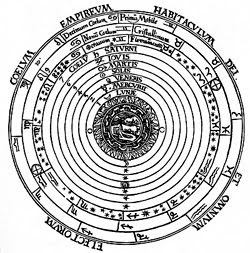
music of the spheres
F
IRST USED IN E
NGLISH in 1570s the word
phenomenon is traced back to the Greek
phainesthai 'to appear, to seem' from
phainō 'to show, to bring light'. For instance in
The Odyssey, when marking the start of a new day, Homer often used the lovely phrase:
phanē rhododaktulos Ēōs "Dawn's rosy fingers appeared".
Phainō can also mean 'to make known' via the metaphor 'to see is to know'.
From the Greek come such words as
fantasy,
fancy,
phantom,
emphasis, and
diaphanous. The PIE root is *
bhā 'to shine'. Via Germanic cognates we get words such as
banner,
beacon,
berry. In Latin a
phantasma is the name for an apparition or spectre. Also via Latin we get
epiphany,
sycophant,
hierophant. The root goes into Sanskrit as
bhāsati 'to shine' and
prabhā 'shining' and
vibhāta 'shining forth'.
In English the meaning of
phenomenon varies according to the context but basically it refers to the something known through the senses rather than by the intellect or reason. It can also mean any kind of observable event. Of course a Buddhist definition of phenomena, would include objects of the mind and observable mental events (not all such events are observable from within).
Phenomena are sometimes contrasted with
noumena (from Greek
noeō 'to perceive, to observe, to notice'; probably from a non-IE source since there are no other attested forms, and no PIE root). Before Kant philosophers took noumena to be synonymous with Plato's
ideal forms. Plato likened human perception to seeing shadows cast on the wall of a cave, suggesting that we don't ever see the things that cast the shadows, i.e. the ideal forms (this gives us the label 'Idealist'), or presumably the light which illuminates them. In Kant's philosophy the appearance of thing (
phenomenon) is contrasted with the 'thing in itself' (German
Ding an sich) or
noumenon, and, according to Kant
, noumena are not directly perceptible, we can only intuit their existence from appearances - hence his philosophy is called Transcendental Idealism. Other philosophers hold that noumena can be perceived by the intellect, or pure reason, which might appear to make them akin to the Buddhist notion of the mental sense objects (
dharma), however the differences are great enough to warn us off suggesting noumena as a translation. Although most Buddhist traditions would deny the possibility of noumena outright, some Buddhists find it hard to let go of the notion that there is something beyond phenomena, a transcendental reality, which can be experienced "directly".
The adjective
noumenal (related to noumena) is sometimes conflated with the adjective
numinous, though the latter is from a different root. 'Numinous' is mainly used by theologians to suggest the felt presence of God. This word comes from the Latin
numen 'divine will'. Ultimately we can trace it to the PIE
root *√neu "to nod"; and it suggests ascent by a nod of the head. A related English word is
innuendo.
Because
dharma/
dhamma is often used in the sense of an object of the senses, particularly the mind-sense (
manas), and because it can mean 'a thing', or 'an item' we often translate it as 'phenomenon'. The fit is not exact however.
Dharma comes from the root √
dhṛ 'to hold, to support'. There is a word which would be well translated by phenomenon and that is
vedanā. The root of this word is √
vid 'to know, to find' and is regularly used in words to do with knowledge such as
veda 'sacred knowledge' and
vidyā 'secret knowledge'. We often translate these Indic words with English from the same root, i.e.
wisdom 'experience and knowledge combined with the ability to judiciously apply them'.
Vedanā then is 'the thing known', in effect it is 'what appears', i.e. the
phenomenon. Though again Western thinkers don't typically include mental objects under the rubric of phenomena.
Vedanā is often translated as 'feeling' because in Buddhist doctrine it is associated with pleasure and displeasure (
sāta/asāta or
sukha/dukkha), leading to attraction and repulsion. I tend to translate 'sensation' because 'feeling' allows for
vedanā to be confused with emotions which are colloquially also called 'feelings'. We could say that emotions have a felt component, and a cognitive component. A feeling without a corresponding thought process is possible, but it is usually hard to know what to make of it. In modern terms the feelings of pleasure and pain associated with sensations are part of our internal sense network which includes proprioception, the inner-ear balance organs, the viscera and digestive tract, and other sources of information from within the body itself. We sometimes talk about 'raw sensations' in Buddhism, but this is a bit of a misnomer because even in Buddhist psychology a lot of complex processes have to be active in order for us to become aware of a sensation. What in effect we mean by raw sensation is the
vedanā before it gives rise to craving or aversion. To experience this we have to be relatively detached from pleasure and pain.

From the Buddhist point of view one of the important things about
vedanā is that it arises in dependence on conditions. It is said to arise when there is contact, and contact occurs when sense faculty meets sense object giving rise to sense consciousness - and the three together constitute the condition for the arising of
vedanā. We see a crucial difference in the Buddhist and Western approaches here. The Western intellectual tradition sees our internal world as subjective, as synonymous with the subject. Buddhists see this as a mistake. The subject is involved in creating experience, but only in active interaction with the object. Experience itself then is neither subjective nor objective; it is not a function of either alone, but of the interactions of the two together. I have observed before that this technically means that early Buddhist thought is dualistic - it acknowledges that subject and object are two different things. This is a metaphysical position, and it has wide ranging implications should we choose to follow them up, but the authors of the suttas never did.
Buddhism in the West is still in the process of settling on terminology. Perhaps for the first time in history a culture is having to deal with multiple competing forms of Buddhism which are using radically different oriental vocabulary e.g. Indian, Tibetan, Chinese, Japanese, Thai and Korean. Of these languages only Japanese and Korean are even remotely related (and the relationship is remote in this case). Phenomenon and it's counterpart noumenon are widely used, but the discussion about suitability has yet to really take place. I'm reasonably well versed in Indian Buddhist terminology, but I find I cannot read books on Tibetan Buddhism because they use another set of terms with may neologisms that I don't understand. Similarly I often flounder when reading about Japanese Buddhism. Buddhist jargon is often impenetrable, even to Buddhists.
I'm all in favour of just ditching traditional jargon and Buddhist Hybrid English (English vocabulary with Sanskrit syntax) that doesn't make sense. Perhaps it is time to drop all the words and have a new attempt at describing the procedures of Buddhism, and the experiences that result? A word like
phenomenon shows that it won't be easy, because words come with baggage. On the other hand we are constantly redefining words: think of
terrific (i.e. terrifying
OEtD), or
silly (originally 'happy, blessed'
OEtD). It suggests that there will be a role for philologists—those people who tell us what words mean, and why they mean that—in Buddhism for a long time to come.
~~oOo~~
 SĀRIPUTTA WAS ONE OF THE TWO chief disciples of Gotama the Buddha. He was born a Brahmin and wandered with his companion Moggallāna in search of the deathless. A chance meeting with Assajī lead to his breakthrough insight and becoming a Buddhist. He was held in extremely high esteem by all who knew him, including the Buddha.
SĀRIPUTTA WAS ONE OF THE TWO chief disciples of Gotama the Buddha. He was born a Brahmin and wandered with his companion Moggallāna in search of the deathless. A chance meeting with Assajī lead to his breakthrough insight and becoming a Buddhist. He was held in extremely high esteem by all who knew him, including the Buddha.
 I'
I'
 From the Buddhist point of view one of the important things about
From the Buddhist point of view one of the important things about 


